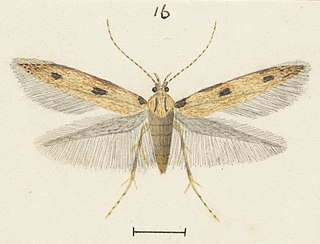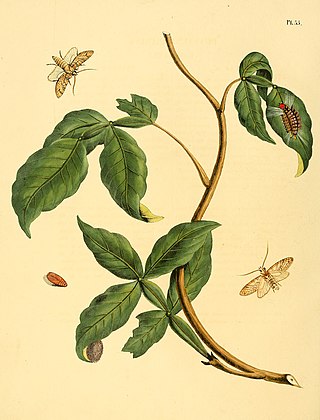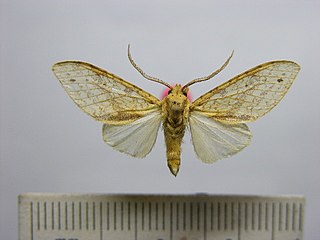
Apamea crenata, known as the clouded-bordered brindle, is a moth in the family Noctuidae. It is distributed throughout the Palearctic realm. In the North it crosses the Arctic Circle, in the Mediterranean it is found only in cool locations and mountains avoiding very hot areas. In the Alps, it rises to an altitude of about 2000 metres.

Apamea lithoxylaea, the light arches, is a moth of the family Noctuidae. The species was first described by Michael Denis and Ignaz Schiffermüller in 1775. It is distributed throughout Europe, the Caucasus, Armenia, Asia Minor and Turkey, and ranges east to the Altai Mountains.

Hydraecia micacea, the rosy rustic, is a moth of the family Noctuoidea. It is found across the Palearctic realm from Ireland to Siberia. It reaches Japan and is introduced to eastern USA, Quebec and Ottawa.

Synthymia is a genus of moths of the family Noctuidae. It contains only one species, Synthymia fixa, The Goldwing, which is found in southern Europe and North Africa.

Apamea scolopacina, the slender brindle, is a moth of the family Noctuidae. The species was first described by Eugenius Johann Christoph Esper in 1788. It is found across the Palearctic realm from central Europe to the Kuril Islands northeast of Japan.

Eudocima salaminia, the green fruit-piercing moth, is a moth of the family Erebidae. The species was first described by Pieter Cramer in 1777. It is found from India, and across south-east Asia to the Pacific Islands. In Australia it occurs in the Northern Territory, Queensland and New South Wales. The adult is a fruit piercer.

Nycteola revayana, the oak nycteoline, is a moth of the family Nolidae. The species was first described by Giovanni Antonio Scopoli in 1772. It is found from Europe and east across the Palearctic to Japan and India.
Hellinsia linus is a moth of the family Pterophoridae first described by William Barnes and Arthur Ward Lindsey in 1921. It is found in North America, including Pennsylvania, Ohio, Maryland and Massachusetts.
Hellinsia cochise is a moth of the family Pterophoridae that is found in Arizona. The species was first described by William Barnes and Arthur Ward Lindsey in 1921.
Hellinsia perditus is a moth of the family Pterophoridae first described by William Barnes and Arthur Ward Lindsey in 1921. It is found in the US states of California and Colorado.
Doloessa is a genus of snout moths. It was described by Philipp Christoph Zeller in 1848 and is known from India, Australia, New Guinea, Japan, Sri Lanka, Indonesia, and China.

Labdia anarithma is a moth of the family Cosmopterigidae. It was described by Edward Meyrick in 1888. It is found in New Zealand and throughout Australia. Adults are on the wing from December to March and are day flying. They have been collected by sweeping bracken fern.

Lophocampa citrina is a moth of the family Erebidae. It was described by Jan Sepp in 1843 as Phalaena citrina. It is found in Mexico, Honduras, Panama, French Guiana, Brazil, Venezuela and the Amazon region.

Lophocampa debilis is a moth of the family Erebidae. It was described by William Schaus in 1920. It is found in Mexico, Costa Rica and Guatemala.
Udea alaskalis is a moth in the family Crambidae. It was described by Arthur Gibson in 1920. It is a high Arctic species found in North America, where it has been recorded from Alaska. It is also found in Greenland and northern European Russia.
Habrona marmorata is a moth in the family Drepanidae. It is widely distributed in Papua and Papua New Guinea.
Antaeotricha thysanodes is a moth of the family Depressariidae. It is found in Guyana, French Guiana and Brazil.
Notosara nephelotis is a moth in the family Depressariidae. It was described by Edward Meyrick in 1890. It is found in Australia, where it has been recorded from Western Australia.
Antaeotricha ergates is a moth in the family Depressariidae. It was described by Lord Walsingham in 1913. It is found in Mexico (Tabasco).
Stenoma ulosema is a moth in the family Depressariidae. It was described by Edward Meyrick in 1930. It is found in Brazil.










